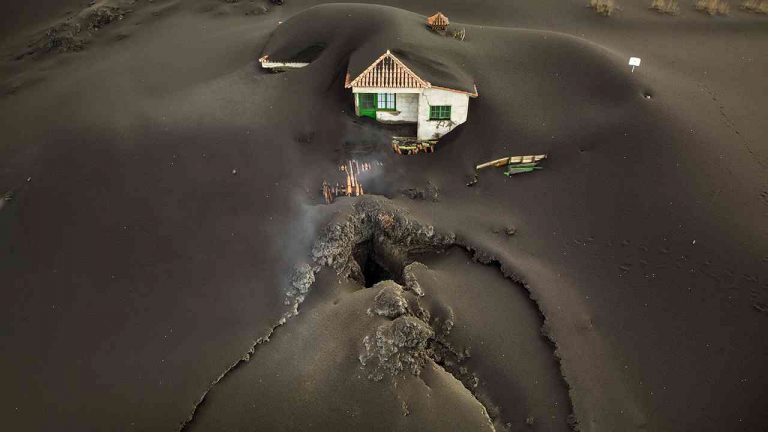A prolonged period of high lava flow has continued to threaten homes on La Palma, in the Canary Islands. The lava is oozing to the surface, adding to concern about the neighbourhoods of Villalobos and Lucena. Flames are visible at high-tide from night-time due to the rising water pressure of the lava. Dozens of people were evacuated in 2014 when lava damaged their homes. The threatened Villalobos and Lucena villages could house between 9,000 and 12,000 people, the island’s government said. Five houses have already been burned down by lava from Carchigal de la Luna in the past few weeks. Residents are resisting attempts to forcibly evacuate them, though the government has promised homes in neighbouring Puerto de La Palma for those who are relocated. It is a problem that has plagued the islands since the 1980s. Lava from Mount Ontake volcano erupted in 2014, destroying about 770 homes in Kawamata in Nagasaki Prefecture, Japan. Around 200 houses were also destroyed in Hawaii by lava fissures in 2015 and 2016.
Enlarge Image
What is happening in La Palma?
At the base of the volcano, the lava is developing a drop towards the ground. Once it makes contact with the ground it creates a crater about 30m (100ft) deep and a crater lake. Scientists are optimistic that the lava flow will eventually cover all of the Llano Grande area. At the same time, the movement of lava water and debris on the surface will create currents, particularly in the week before high tides. In the nearest seaside communities, the weather system is expected to cause some difficult sailing conditions for local boats, though it is not expected to worsen the current cycle of threat and evacuation.
Discover how volcanic earthquakes have made the Earth move [Video link] What happens next?
La Palma officials are planning a pre-planned evacuation of residents from the affected zones. Some residents are resistant, but the number of people who wish to remain is limited. The number of people who have left town is now restricted to around 5,000, according to the BBC’s Peter Lloyd. The island government is also trying to encourage existing residents to leave town and move to Puerto de La Palma. There is no safety or property values issue involved with relocating, so there are no initial costs involved. The island’s mayor wants to work with the private sector to persuade people who wish to remain to do so so their land can be returned. “Unfortunately, currently there are people who refuse to move,” Antonio Frutos Marin said. “That is unacceptable.” So far, Villalobos and Lucena have been the only two neighbourhoods to be completely evacuated as a result of the current eruptions.
How is the Met Office watching La Palma?
The weather service is watching the volcano’s progress closely and has upgraded its yellow (hazardous) and orange (very hazardous) warnings to red (critical). The evacuation is still being thought about, but will take place early in the morning. La Palma is in the area of the Mediterranean called Espanola, which is the main geophysical focus for the whole island. The severe weather caused by the eruption has also prompted the warning of possible evacuation for 12,000 people in the nearby fishing harbour of El Fajardo. It is not unusual for volcanic activity to disrupt the northern coast of the Canary Islands, as sea temperatures are generally low.
BBC News Switch: La Palma air traffic safety risks
BBC News Switch: Fact and fiction About volcanoes is a regular feature on BBC News. This week’s takes a look at volcanic activity in the Canary Islands, but here we look at the island of Crete. Crete is a Cyclades island off the southwestern coast of Greece. Its volcanic activity typically begins at low levels of activity followed by a series of eruptions. A major eruption of the island’s southern volcano has happened twice since the 12th Century.
[Frontpage image: Carchigal de la Luna]
Carchigal de la Luna: Where did the lava go?
Carchigal de la Luna was created when the oldest lava of Mount Lemnos burst from the ground (carchigal). It was in the crater of a former volcano called Rhenot, which used to be located at an altitude of 780m (2,429ft). Lechonos remains a mountain in western Crete and has the highest lava flow of any of the volcanoes in the island. It is an active volcano and has caused sporadic eruptions during the last century. The seaside village of St. Aphrodite’s comes into view before the expected violent eruption
Carchigal de la Luna: Named after a queen of Atlantis, Don Pedro del Palma II, it rises 1,895m (6,815ft) above sea level. Over
